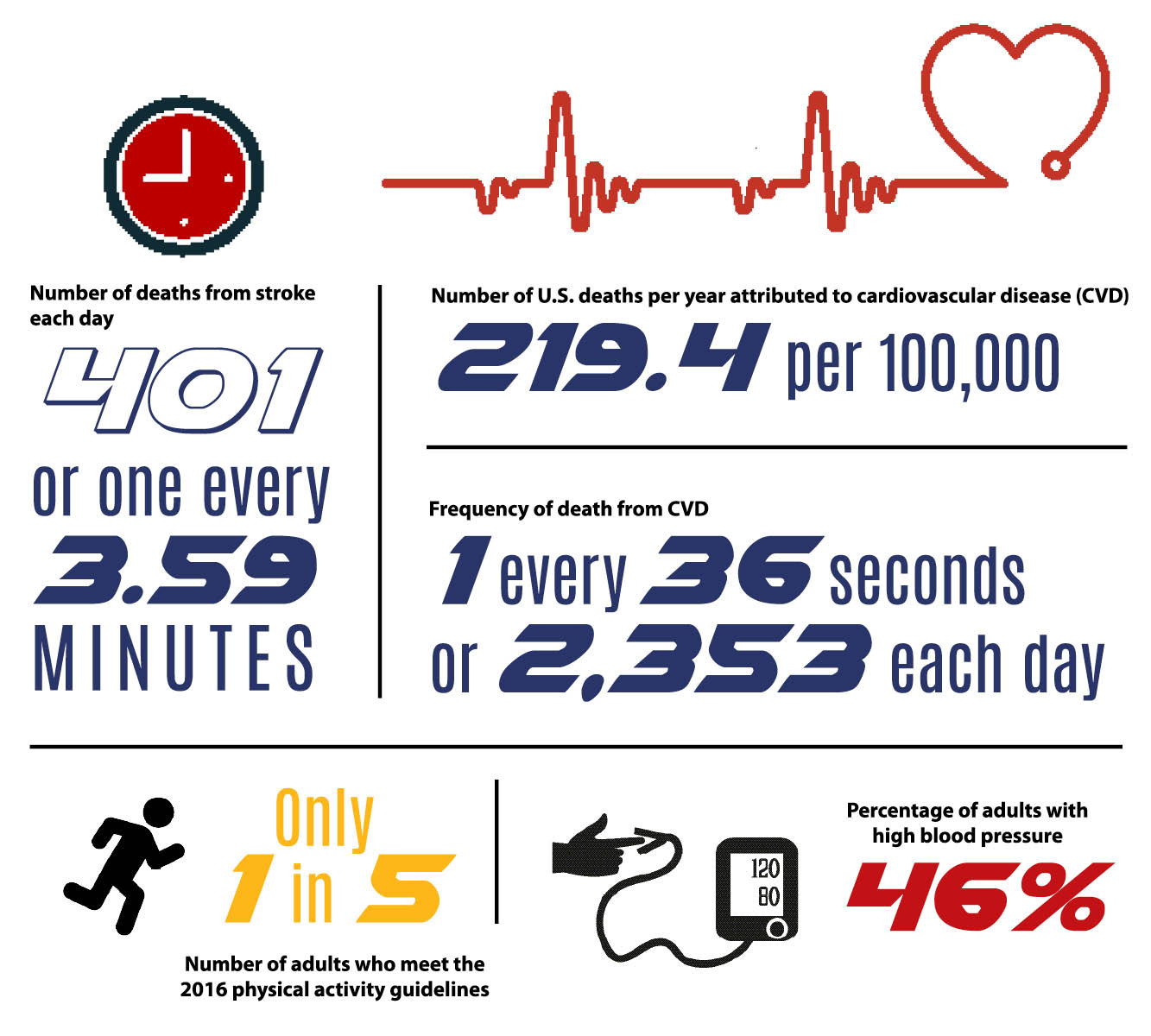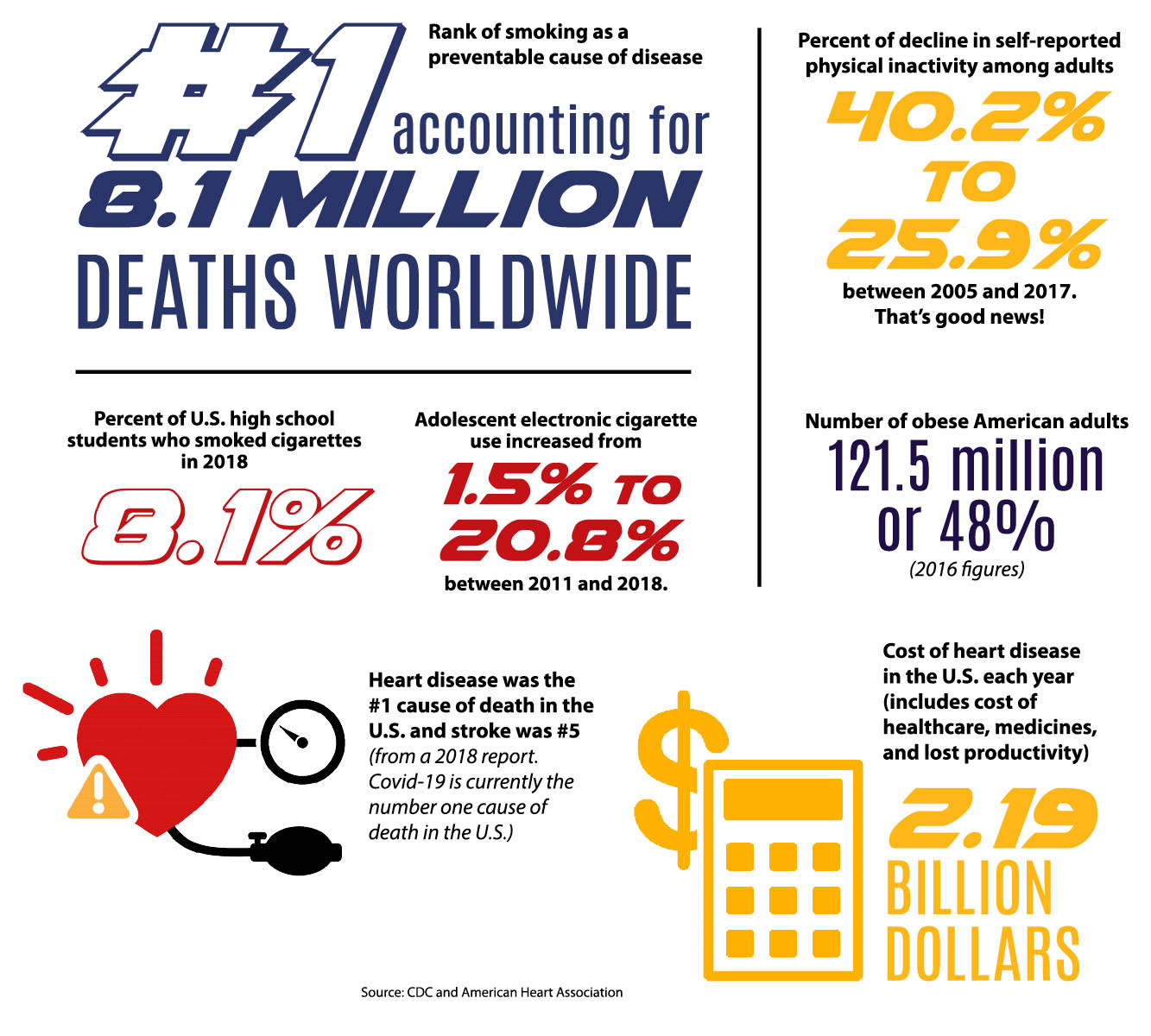
Adding Winter Blues to the Mix
January 2021
When Allergies Become Extreme
February 2021You might think hearts are front and center in February because of Valentine’s Day, but this month is also American Heart Month. This designation was instituted by President Lyndon B. Johnson in 1964 to encourage and motivate people to adopt heart healthy behaviors. In this special section on Heart Health, you’ll find stories on How Spouses Share a Lot – including heart healthy habits, the Benefits of Cardiac Rehabilitation, and a page full of fascinating statistics on heart disease in our By the Numbers feature.

Approximately 800,000 people in the United States have a heart attack every year. Around one in four of those people already had at least one heart attack. Cardiac rehabilitation not only can help a person recover from a heart problem but can also prevent future heart problems.
What is cardiac rehabilitation?
Cardiac rehabilitation is an important program for anyone recovering from a heart attack, heart failure, or other heart problem that required surgery or medical care. This supervised program includes:
- Physical activity.
- Education about healthy living, healthy eating, medicines, and smoking cessation.
- Counseling to find ways to relieve stress and improve mental health.
- A team of people may be involved in your cardiac rehabilitation, including your health care team, exercise and nutrition specialists, physical therapists, and counselors.
Who needs cardiac rehabilitation?
Anyone who has had a heart problem, such as a heart attack, heart failure, or heart surgery, can benefit from cardiac rehabilitation. Studies show that cardiac rehabilitation helps people of all ages, and people with mild, moderate, and severe heart problems. However, some people are less likely to start or finish a cardiac rehabilitation program.
Studies show that women, especially minority women, are less likely than men to start or complete cardiac rehabilitation. This may be because doctors may be less likely to suggest cardiac rehabilitation to women.
Older adults are also less likely to join a cardiac rehabilitation program following a heart problem. They may think they are unable to do the physical activity because of their age, or they may have other conditions that can make exercising harder, such as arthritis. The need to address other physical conditions makes cardiac rehabilitation especially useful for older adults, since it can improve strength and mobility to make daily tasks easier.
How does cardiac rehabilitation help?
Cardiac rehabilitation can have many health benefits in both the short and long term, including:
- Heart and body strengthening after a heart attack.
- Relief of heart problem symptoms, such as chest pain.
- Healthier habit formation such as getting more physical activity, quitting smoking, and eating a heart-healthy diet. A nutritionist or dietitian may work with you to help you limit foods with unhealthy fats and eat more fruits and vegetables that are high in vitamins, minerals, and fiber.
- Stress reduction.
- Improved mood. People are more likely to feel depressed after a heart attack. Cardiac rehabilitation can help prevent or lessen depression.
- Increased energy and strength to make daily activities like carrying groceries and climbing stairs easier.
- Making you more likely to take your prescribed medicines that help lower your risk for future heart problems.
- Future illness and death from heart disease prevention. Studies have found that cardiac rehabilitation decreases the chance that you will die in the five years following a heart attack or bypass surgery by about 35%.
Where can you get cardiac rehabilitation?
Some programs are conducted in a hospital or rehabilitation center, and other programs can be done in your home. Cardiac rehabilitation may start while you are still in the hospital or right after you leave the hospital. Programs usually last about three months but can range anywhere from two to eight months.
If you have a heart attack or other heart problem, cardiac rehabilitation is an important part of your recovery. Cardiac rehabilitation can help prevent another, perhaps more serious, heart attack and can help you build heart-healthy habits. Talk to your doctor about cardiac rehabilitation. Many insurance plans, including Medicaid and Medicare, cover the program if you have a doctor’s referral.
Source: cdc.gov

Many married couples or domestic partners share a lot: the same house, bills, pets and maybe children. A new study found they often also share the same behaviors and risk factors that can lead to heart disease.
Researchers assessed heart disease risks and lifestyle behaviors of nearly 5,400 U.S. couples enrolled in an employee wellness program.
They used the risk factors spelled out in the American Heart Association Life’s Simple 7: smoking status, physical activity, healthy diet, total cholesterol, blood pressure, fasting blood sugar and body mass index (BMI, a measure of body fat based on height and weight). They categorized participants’ results individually and as couples as poor, intermediate or ideal for each risk factor and overall.
“The good news is that some of them, 1 out of 5 [couples], were both ideal, but the fact that 4 out of 5 were in the non-ideal category is really worrisome,” said study co-author Dr. Samia Mora, a cardiologist at Brigham and Women’s Hospital in Boston.
Even more concerning: The study population tended to be entering or in middle age. Men ranged from 41 to 57 years old; women, from 39 to 55.
“We know that risk factors get worse with age and also that our risk for cardiovascular disease increases a lot with age,” Mora said “So, what you do earlier in life really matters for the future.”
The couples had joined a corporate health assessment program between October 2014 and August 2015. Their health status was assessed through questionnaires, exams and lab tests. Researchers also followed about 2,200 of those couples through five risk assessments that continued through 2018.
The wellness program was similar to those many companies offer their employees. This one included spouses and partners, and data was available for both, Mora said. Participants came from all over the United States and represented diverse economic and racial backgrounds.
Only 12% of individuals had ideal scores for heart health, the study found. Though more than half were in the ideal category for smoking, total cholesterol and fasting blood sugar, more than a quarter rated poor for BMI and adequate exercise.
About 79% of couples had less-than-ideal scores for heart risk - mainly due to unhealthy diets and inadequate exercise, the study found.
The findings were published Oct. 26 in JAMA Network Open.
Jannie Nielsen, an assistant professor at Emory University’s Rollins School of Public Health in Atlanta, reviewed the findings.
She said people often choose a partner who is quite similar to them, whether because they have similar economic status or share interests, like exercise. And once they are together, they tend to share habits, especially what they eat, Nielsen said.
Other studies have shown that spouses of individuals who participated in a weight-loss program also lost weight during that time, she said.
“You could hypothesize that because one person is in an intervention, they may change what they eat at home,” Nielsen said.

Several factors could influence what a person chooses to eat, including the foods one grew up with, their economic status and in-store marketing that may steer a shopper to certain food choices, she said.
“I think it’s based on how you grew up, it’s based on what you can afford, but also on time,” Nielsen said. “If you’re working, do you want to cook a big meal from scratch or do you want to buy something you can just heat up? A lot of factors [are] playing there.”
While most health and prevention programs are focused on individuals, Mora said this study showed that behavioral modification may benefit both the targeted individual and his or her significant other.
“The key here is that if we are able to expand our approach for prevention and not just focus on individuals, but focus on household or even potentially bigger units like communities, we may have a lot more benefit,” she said. “We know that having a support system really helps people to change their behavior because behavior is hard to change.”
Article and sources can be found in the CHRISTUS Ochsner Health SWLA Private Health eNewsletter.
CHRISTUS Ochsner Southwestern Louisiana’s monthly enewsletter keeps you informed with the latest health and wellness news on the topics you choose. Additional resources such as health reminders and a maternity newsletter are also included with your free subscription.
To subscribe visit, https://christusochsner.privatehealthnews.com/









